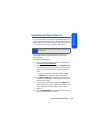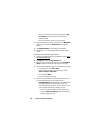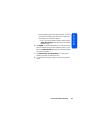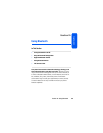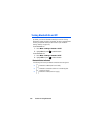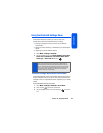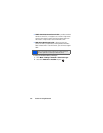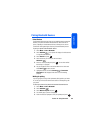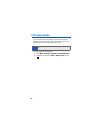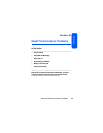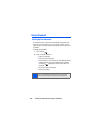
Section 2L: Using Bluetooth 193
Using Bluetooth
Supported Bluetooth Profiles
All the Bluetooth settings you configure are stored in your phone’s
Bluetooth user profile (also known as the AG Profile). Different profiles can
be used for specific Bluetooth functions.
ⅷ HSP: Headset Profile—Bluetooth technology connects the phone to
a wireless Bluetooth-enabled headset. When an incoming call is
received, the ringer can be heard through the headset instead of
through the phone. The call can then be received by pressing a button.
Increase or decrease the volume by using the volume key on the side
of the phone.
ⅷ HFP: Hands-Free Profile—Bluetooth technology connects the phone
to a wireless Bluetooth-enabled car kit. Incoming calls ring to the
hands-free headset or device. Calls can be received by pressing a
button on the headset or device. For dialing, four functions are
supported: recent call dial, voice dial, speed dial, and number dial.
Increase or decrease the volume by using the volume key on the side
of the phone.
ⅷ DUN: Dial-Up Network Profile—Bluetooth technology functions as
a wireless data cable, connecting a PC or PDA to a network through
your phone.
ⅷ OPP: Object Push Profile—based on the Generic Object Exchange
(OBEX) profile which uses predefined object formats. The object
formats are vCard, vCal, vMsg, and vNote.
ⅷ FTP: File Transfer Protocol—based on the Generic FTP Protocol to
exchange files.
ⅷ BPP: Basic Printing Profile—Bluetooth technology functions as a
PictBridge printing connection to a printer from your phone.
ⅷ A2DP: Advance Audio Distribution Profile—transfers a two-
channel stereo audio stream, like music from an MP3 player, to a
headset or car radio.



